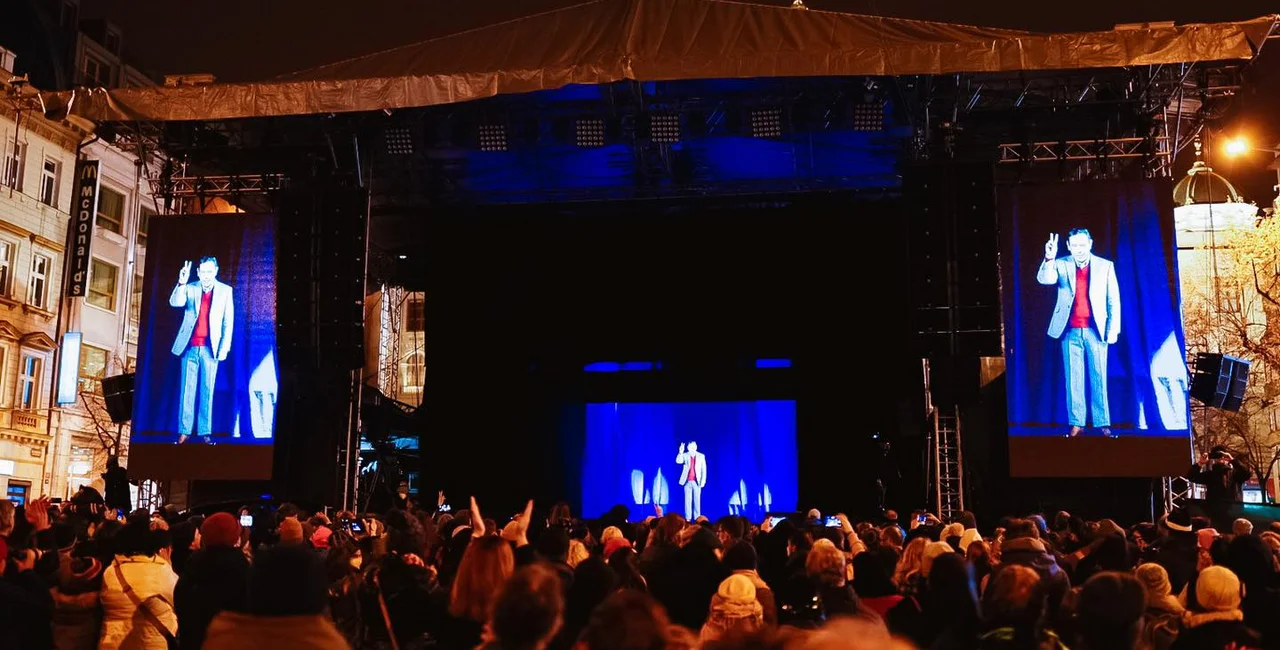Celebrations for the Nov. 17 holiday, officially called Struggle for Freedom and Democracy Day, brought tens of thousands of people to Národní třída and Wenceslas Square, while Old Town Square was filled with people rallying against the government’s Covid restrictions. People also gathered at Albertov, a key location in the events of 1989.
The holiday marked 32 years since the Velvet Revolution brought an end to communism in then-Czechoslovakia.
PARTNER ARTICLE
It is also 82 years since the Nazis closed Czech universities, following protests over the death of medical student Jan Opletal, who had been shot at an Oct. 28, 1939 student rally. Many student leaders at that time were sent to concentration camps.
“The number of visitors exceeded what we expected,” Lucie Bílková, from the organizing group Díky, že můžem (Thanks That We Can) told the Czech News Agency (ČTK).
It was also almost 10 years since the death of former president Václav Havel, who died Dec. 18, 2011. Havel made an unexpected appearance at the Koncert pro budoucnost (Concert for the Future), held on Wenceslas Square.
He appeared as a hologram and gave a speech following a half-hour set by concert headliner Glen Hansard, known for his work the Frames as well as Czech singer and pianist Markéta Irglová.
The Havel hologram was created using gestures and facial movements from actor Robert Mikluš, who has played Havel on stage and also knew him. The voice came from impressionist Petr Jablonský. The face of Havel was added by media professionals who have experience with deep-fake videos.

Havel’s seven-minute speech was made up of quotes from his speeches between 1989 and 2009, with the help of Michael Žantovský, director of the Václav Havel Library. The hologram Havel pointed out that the world is more interconnected than ever before, and is also in more danger.
“Truth and love must triumph over lies and hatred. I am happy to see this sentence still irritates some," the hologram of Havel said.
After the speech, Czech opera star Adam Plachetka sang the Czech national anthem, “Kde domov můj.” The concert began at 4:30 pm and featured speeches as well as other musicians. Representatives for nongovernmental organizations, in particular, drew attention to the situation in Belarus.
In the upper part of Wenceslas Square, there was a smaller stage with additional speakers. A sculpture of Russian President Vladimir Putin with a miniature Belarusian leader Alexander Lukashenko on his knee was next to that stage. Some people also had a large Ukrainian flag and tried to draw attention to the situation there.
As is the case every year, politicians and common people left candles and flowers in front of the Nov. 17 memorial on Národní třída. People also lit candles in front of the Havel memorial at the National Theatre, a lit heart with Havel’s signature above it neon lights. The plaza behind the National Theatre has been known as náměstí Václava Havla since 2016. There were also a few candles outside the Václav Havel Library on Ostrovní Street.
At 5:11 pm (17:11), singer Jana Kirschner sang “Modlitba pro Martu” (A Prayer for Marta) from the balcony of the Czech National Theatre. It was broadcast nationwide and also carried over public address systems. The song is considered the anthem of the Velvet Revolution.

The song was originally sung in 1968 by Marta Kubišová. In the era of Normalization after the Soviet-led invasion, she was banned from public performances for almost 20 years. Her songs including “Modlitba” were banned from the radio and TV until 1989.
Národní was filled with historical exhibitions on information panels, audiovisual projections, a line of East German-made Trabant cars, and two classic T3 trams with the fictitious route number 89.
A parade of thousands of people from the rally at Old Town Square arrived at Národní třída at around 6 pm. Some carried signs opposing vaccination and comparing having to show a vaccination certificate to Jews having to wear yellow stars during the Holocaust. They passed through Národní without incident.
A part of the program was held indoors in the buildings along Národní třída, which were illuminated in the Czech national colors of red, white, and blue.

A drone show sponsored by Česká spořitelna took place at over the Vltava river between the Legion Bridge (most Legií) and Jirásek Bridge (Jiráskův most) at 6:30 pm. Coordinated drones made several images including the Czech flag, fingers extended in a peace sign, and keys as a reminder of the ones people jingled on Wenceslas Square in 1989.

Another side event was the dedication of a new bust of Havel at Cafe Slavia on Národní třída. The bust was carried in a backpack from in front of the statue of Tomáš Garrigue Masaryk to the cafe and delivered by actress Anna Geislerová around 5 pm. Glen Hansard performed a few songs at the event before heading to Wenceslas Square.
Many buildings in Prague and across the Czech Republic were lit in the Czech colors. These included the Petřín Lookout Tower, the prime minister’s residence at Kramářova vila, the Philosophical Faculty of Charles Univesity, BB Centrum, the National Technical Museum, the Česká spořitelna building, and the Czech Television building at Kavčí hory.
Sites in Olomouc, Plzeň, Litvinov, Hradec Králové, Chomutov, and other cities also participated, as well as the Bohemian National Hall in New York and the Czech Pavilion in Dubai.
Dozens of students and university representatives met in Albertov to mark the anniversary of events of 1939 and 1989. The student demonstration set out from Albertov 32 years ago, heading for the Prague center. It was violently suppressed by police at Národní třída. This led to the collapse of the communist regime in Czechoslovakia.
Speakers in Albertov remembered the courage of students in 1989 and 1939. Nov. 17 is known worldwide as International Students Day in remembrance of the Nazi crackdown on Czech universities in 1939.












 Reading time: 4 minutes
Reading time: 4 minutes 


















































